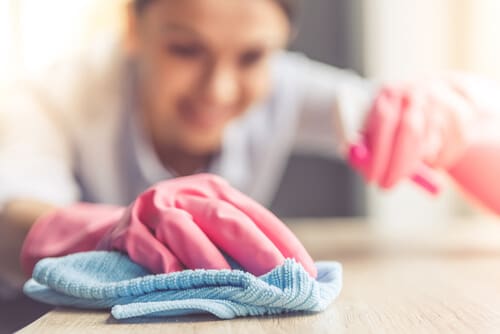I have never been crash-hot on domestic cleaning. My natural indolence was once reinforced by a country farming woman who told me that she kept her house spotlessly clean, which became a problem for her kids when they went to boarding school.
See, your home can be too clean. They’d never built up any resistance or immunity so they were easy prey for any bugs and lurgies that their city peers were carrying around.
And I have a friend who’s a brain surgeon who’s even slacker than I am. “If I wanted to operate in my bathroom, it would be sterile, but I don’t so it isn’t,” he once said.
The fact is, that for everyday household germs, the 99.9 percent that domestic disinfectants deal with, we are pretty good at warding them off without needing disinfectant air spray (whatever happened to that gimmick?).
But right now, there’s a nasty germ going around that does need to be dealt with before it deals with you.
So last week Sue ignored the howls of laughter from her family, as described in the podcast, and wrote a definitive guide to domestic cleaning for the Sydney Morning Herald.
Cleaning to beat Covid
By Sue Williams
As the build-up of dust and grime in our homes threatens to choke those of us without our usual cleaners during lockdown, it’s time to relearn the basics of what once used to be called good housekeeping.
Outsourcing has meant overlooking what it takes to keep ourselves neat and tidy, and, too often, completely forgetting.
“That’s exactly why our book Spotless was so successful when it came out,” says Jennifer Fleming, who co-authored the book with Shannon Lush. “It was about going back to our grandmothers to remind ourselves of their tips and tricks.
“And now, with lockdown, everyone’s at home a lot more, so we have to increase our rate of cleaning, too.”
There are lots of jobs that need to be done daily, especially with COVID-19 making it even more critical we stay hygienic and healthy.
Benchtops, bathroom vanities and all high-touch points, like door handles, toilet flushes, light switches and microwaves doors should be wiped down every day, while dishes should be stacked in the dishwasher at the end of each meal.
Beds should be made – especially if you’re doing Zoom calls in the bedroom – and a quick tidy-up at the end of the day will prevent mess becoming a major job to clear later.
Computers
At commercial green cleaning company Havencab, cleaning operations director Diego Canavero also stresses the home office.
“With so many people working from home or home-schooling now, those touch points that have to be sanitised daily also include your computer mouse, phone and home office drawers,” he says. “Then keyboards should be cleaned at least once a month.
“With COVID, we have to sanitise a little bit more than we used to and be even more careful about cross-contamination of different areas. At home, we use a red cloth for the kitchen, a blue cloth for the bathroom and a yellow cloth for the general areas.”
Vacuuming can be done once every three days or so, depending on foot traffic, while once a week bathrooms and kitchens should be cleaned thoroughly, floors swept and mopped, and sheets and towels changed.
Fortnightly, Fleming recommends a damp cloth be used to remove the dust that gathers over skirting boards and lavender oil for wiping down door jambs to give the home an inviting smell.
Oven racks
For the more painful jobs, like cleaning the oven, Rachel Hallet of Mums Who Clean recommends making it easier with a dishwasher tablet. “Simply wrap one of your oven racks in foil and soak in a large tub of hot water,” she says. “Throw a few dishwasher tablets in the water, one per rack, and leave for at least two hours or overnight. All those baked-on spots will wipe off easily with a cloth or fine scourer.”
A sticky lint roller in the bedroom monthly will remove dust from fabric lamps and bed heads
Involve the family too, says Jessica Bragdon, the co-founder of eco-friendly, non-toxic products Koala Eco. “Get the kids to help with something every day,” she says. “I tell them if they argue, they get a task.
“There have also been studies that show the most germs enter our homes when we track them in on our shoes, so as soon as you come in, take them off and wash hands. That’s a huge win in keeping homes clean, and very easy to do.”
Dusting
Dusting should always be done from the top down, she adds, from ceiling fans to bookshelves, to tables, and then vacuuming upholstery and carpets afterwards. Cushions should be beaten by hand to get rid of dust.
But if you’re feeling overwhelmed by an out-of-control home, Rachel Hallet advises starting with one thing at a time. “You might like to fully clean one room to feel ‘instant’ gratification or, like me, you might prefer to go task by task, picking up all rubbish and then moving all dirty washing to launder then collecting dishes and washing a load,” she says.
“Just those basics can kick you into gear and overcome that cleaning anxiety.”
If you like this post or find it helpful, please share it with interested friends using the social media buttons. If you wish to respond, registered readers can add a comment at the foot of the story or, we’d prefer, on the Flat Chat Forum.





› Flat Chat Strata Forum › Current Page